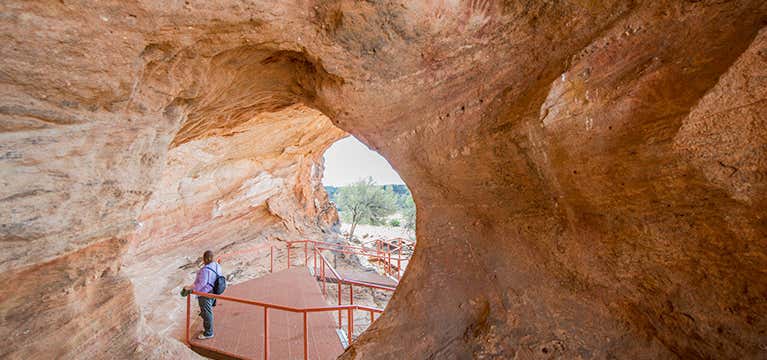Whilst the Northern Territories and Western Australia are famous for their Aboriginal art and the many centuries old historic sites nestled in the national parks, if you are visiting New South Wales, or simply staying in Sydney, then you needn’t suffer FOMO as there are extraordinary sites and galleries as handy as central Sydney or only a few hours out of the city. Branch out further afield and you will discover desert paintings, engravings, stencils, bark paintings, middens from communities of long ago and tastes of local Aboriginal culture that will enrich your understanding of the world’s most ancient living culture.
Art Gallery of New South Wales
Sydney is such a vibrant and cosmopolitan city, rich with art and awash with a diverse mix of peoples and cultures. And as a reflection of this, the Art Gallery of New South Wales has the largest permanent exhibition of Aboriginal and Torres Strait Islander art in the world. So it makes sense that your first Sydney stop, on a trip exploring Aboriginal culture, is the art gallery. Housed in the Yiribana gallery, there are over 2,000 works that illustrate the lifeblood of Indigenous communities. Over the centuries artists have passed on their knowledge and the ways of their people to proceeding generations, keeping their traditions and their stories alive into the 21st century. The Art Gallery of NSW represents artists from communities across Australia and whilst some of the earliest works date back to the late 19th century, the stories of the ancestors depicted in many of the works can be centuries old, or alternatively there are contemporary expressions of Aboriginal communities living urban lives today.
1
Museum of Contemporary Art Australia - MCA
Once you have spent hours perusing the works in the Art Gallery of NSW, head down to the Rocks, Sydney’s historic and once notorious, now busy and vibrant waterfront. At the centre of the Rocks waterfront area is Sydney’s magnificent Museum of Contemporary Art, a superb example of how beautifully modern architecture can sit alongside historic architecture. The MCA along with an array of contemporary artists, recognises and celebrates the history of the original peoples of Australia; Torres Strait Islanders and Aboriginal people. The artworks on display are contemporary expressions of these people’s history; modern interpretations of their ancestors rock art, engravings and stencil art, to name but a few genres; through which they can tell the stories of the ancestors as well as those of being dispossessed of their land and the broader impacts of colonisation. The collection is mind blowing, bringing together works from all over Australia. MCA regularly holds exhibitions, from sculpture exhibits to bark paintings, photography to installations that cover entire rooms, so it’s well worth checking out what’s on display and making sure you leave plenty of time to soak it all in. And following an afternoon exploring the MCA, you’ll be thrilled that they are based in The Rocks as you’ll need to sit down, grab a drink and luxuriate on the blissful waterfront setting, mulling over everything you’ve seen, heard, touched and contemplated.
A relatively short car trip from Sydney is the magnificent Ku-Ring-Gai Chase National Park. If you’re interested in learning about Australian Indigenous culture, then you should set aside some time to visit this wonderful part of NSW. Ku-Ring-Gai is home to around 1,500 pieces of Aboriginal rock art, and is renown for being the most prolific concentration of Aboriginal sites in Australia. There are rock engravings, burial sites, caves, marriage areas and middens. The art describes the lives of the people living in bygone centuries, for instance in one cave there are fish stenciled on the walls and in another hand stencils illustrate to clan members that this was a safe place.
3
Aboriginal Heritage Walk
Follow the Aboriginal Heritage Walk, which combines both the Resolute and the West Head walking tracks to see rock art - both stencils and engravings - and to access the Red Hands Cave of the Guringai people. The stencils are thought to have been painted between 500 and 1,600 years ago by artists chewing a mix of ochre and water into a paste. The subsequent collage adorning this cave is so vivid, it’s easy to imagine the artist hundreds of years ago. Along the track leading to the Red Hands Cave, you also get glimpses of daily life with axe grinding grooves embedded in rocks nestled beside Camp Fire Creek.
Further on the path will lead you to an historic shelter where families would gather around fires in the cooler months. This area is pretty sacred as the arrival of the European settlers was disastrous for these people. The outbreak of smallpox, in the year of the first fleet’s arrival, decimated them. So please be respectful at all time at this special site.
4
Waradah Aboriginal Centre
Only an hour or so out of Sydney is the rugged yet dramatic Blue Mountains, renown for steep brutal cliffs, seemingly endless eucalyptus forest and thundering waterfalls. But the Blue Mountains is also home to Waradah Aboriginal Centre, an Aboriginal contemporary gallery that showcases local artworks and hand crafted didgeridoos in addition to hosting informal cultural sessions and traditional song and dance performances - the Corroboree. Set near the majestic Three Sisters, you will get the opportunity to learn about several Aboriginal tribes, the Dreamtime story behind the creation of the didgeridoo and be witness to a smoking ceremony to boot.
5
Nyanga Walang Aboriginal Tours
Seeing the countryside from an Indigenous perspective is a great way to further your appreciation of this ancient culture. If you’re heading northwards stop in at Gosford and spend some time on a Nyang Walang Aboriginal Tour, learning of the Dreaming whilst viewing the landscape from an Aboriginal view point. Go on a walkabout and you will not only get to see beautiful beaches and lookouts, but you’ll have a chance to get up close and personal with traditional rock engravings, middens where their ancestors gathered, and join them in the sacred circle on the beach, dancing and singing accompanied by the didgeridoo.
Driving further North you head towards Worimi Conservation Lands, where history, culture and down and dirty fun combine when you pack yourself off for a spot of sand boarding down the dunes with Sand Dune Adventures, (owned by the Worimi Local Aboriginal Council). Not only can you surf down these squeaky white sand dunes, but you can hop aboard a quad bike tour and ride the dunes. But do make sure you request the Aboriginal culture and sand board options so that you can learn about the history of the area and the people who have lived here for many centuries, as well as blasting down the dunes.
If you’re not much of a biker, leap aboard one of the modified Hummers for a Hummer special - racing along the biggest dunes with terrific views from their specially made glass viewing canopy. They will take you past the WW2 tank traps, past the Sygna shipwreck and teach you about both Aboriginal and European occupancy of the Dunes. The earliest occupants of the area were the Worimi Aboriginal people and you can see their middens - some up to 12,000 years old - on this tour. The super crazy thing about these middens is that given the shifting nature of the dunes, some days some are revealed and at other times they will be hidden - awash with sand. Don’t be too concerned about missing out, if you sign up for one of these tours you too will get the opportunity for a spot of sandboard riding, surfing down the dunes.
7
Nura Gunyu (Swan Country)
Heading to the South takes you along the coast. But before you reach the shores, make sure you stop in at Nura Gunyu (Swan Country), near Burrill Lake and spend some time with Noel Butler. Noel is a Budawang elder from the Yuin Nation and he is passionate about his people and their traditions. Noel will lead you on an experience foraging for bush tucker and learning about the medicinal aspects of certain plants, you can have cooking demonstrations, even camp overnight - all the while learning the stories of the people.
8
National Museum of Australia
If you’re trip extends to visiting Canberra in ACT, you must spend some time wandering the halls of the National Museum of Australia. Architecturally based on the theme of knotted ropes - to symbolise bringing together the stories of all Australians - the museum does just that, it brings together the stories of over 50,000 years of Indigenous history, art and culture. They hold regular exhibitions in addition to the permanent exhibitions. One really symbolic and powerful exhibition is based on the Canning Stock Route. An infamous pastoral route across Western Australian, developed to bring outback stock to market, The Canning crossed Aboriginal lands without consent and employed shackled Aboriginal “guides” to find watering holes along the way. The NMA Canning Stock Route collection includes paintings, sculpture, cultural objects as well as documentary material and oral histories of over 60 artists who themselves journeyed along the route.
9
Wiradjuri Aboriginal Cultural Tour
Driving South-West from Canberra is where you need to set off for if you are keen to experience the wonder of the Snowy River and the Kosciuszko National Park. From snow sports in the Thredbo-Perisher area to walks and camping in the forested areas, fishing and extraordinary look outs in the Khancoban area, the highlights of this epic wilderness are too long to list. However, it is here, in the Kosciuszko National Park along the Tumut River where the Aboriginal people of this area used to pass on their travels and meet for trade and for ceremonial purposes. So hook up with the team at Wiradjuri Aboriginal Cultural Tours to witness the traditional practices that were dictated by the seasons and the consequent changes in the landscape. Create your own bush rope, jewellery and learn traditional basket weaving and about bush tucker, their tools and the spiritual beliefs described in the Dreaming stories.
Continue exploring in a North-Westerly direction - whilst being a fair distance - gives you a taste of the classic Australian road trip with miles and miles of outback swishing by your drivers window. However the investment of time is well paid off when you reach the Mutawintji Historic Site. If the extraordinary landscape of Mutawintji isn’t spectacular enough, the Aboriginal art at the Historic Site will absolutely fit this bill. WIth one of the best collections of Aboriginal art in the state, it’s well worth joining the 2-4 hour tour - the only way to see these sites. Whilst the distance covered isn’t too long, some of the areas are a little steep, so make sure you are very suitably attired. At the site you will be treated to beautiful Aboriginal rock art - stencils and engravings - and you’ll get to hear the Indigenous stories of the Dreaming, describing the myths of the land and its ancient people. With a place so magnificent it’s no wonder that people want to stay longer, so book yourself into the Homestead Creek campgrounds so that you can contemplate the magnificence and age of all that you have seen, whilst feeling increasingly minute under the brilliant starscape that will reveal itself under the cover of darkness.
Banner Photo Credit: Website
Explore More Trip Guides
Discover the wonders of Indigenous South Australia
- 13 Places
- 27:03
- 1,354 mi
Western Australia's Indigenous Art and Culture
- 9 Places
- 72:58
- 3,619 mi
Exploring Indigenous Australia - Northern Territory
- 13 Places
- 18:60
- 1,085 mi













